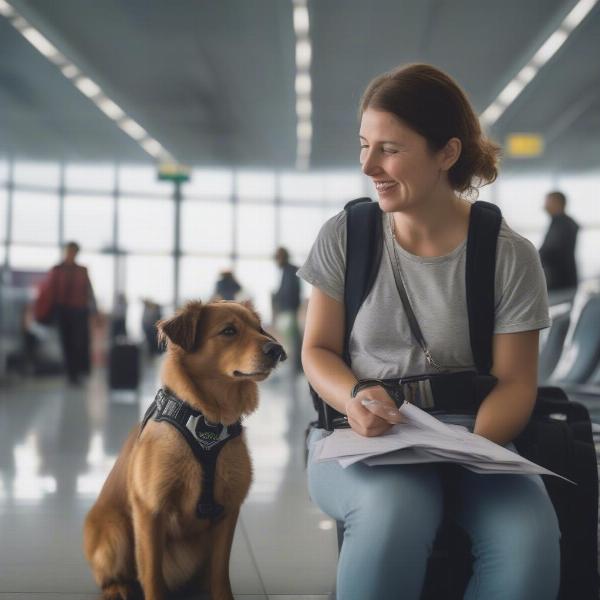Flying with your furry friend can be a stressful experience, especially when wondering about their comfort and safety. Many pet owners consider buying a separate plane seat for their dog to ease these concerns. So, can you buy a plane seat for your dog? The short answer is, generally, no. While the idea of your dog lounging in their own seat sounds appealing, most airlines have strict regulations regarding pets in the cabin. This article will explore the options available for air travel with your dog, including airline regulations, in-cabin vs. cargo travel, and tips for a smooth journey.
Understanding Airline Pet Policies
Each airline has its own specific pet policy, so it’s crucial to research and understand the rules before booking your flight. These policies often include restrictions on the size and breed of dog allowed in the cabin, as well as the type of carrier required. Most airlines allow small dogs and cats that can fit under the seat in front of you to travel in the cabin. Larger dogs typically need to travel in the cargo hold, which has different regulations and requirements.
In-Cabin vs. Cargo Travel: Weighing the Options
Traveling in the cabin is generally preferred by pet owners as it allows them to keep a close eye on their dog throughout the flight. However, limited space and potential disruptions to fellow passengers are factors to consider. Cargo travel, while often necessary for larger dogs, can be more stressful for both the pet and the owner. Temperature and pressure control in the cargo hold are strictly regulated, but it’s essential to understand the risks involved and choose an airline with a good reputation for pet transportation.
Making Your Dog Comfortable During the Flight
Whether your dog travels in-cabin or in cargo, ensuring their comfort is paramount. For in-cabin travel, a comfortable and airline-approved carrier is essential. Familiarize your dog with the carrier well in advance of the flight to reduce anxiety. For cargo travel, choose a crate that is appropriately sized and well-ventilated. Adding familiar bedding and toys can also help comfort your dog during the journey.
Tips for a Smooth Flight with Your Dog
Preparing for air travel with your dog involves more than just choosing the right carrier. Consulting with your veterinarian is crucial to ensure your dog is healthy enough to fly and to discuss any necessary medications or precautions. It’s also wise to avoid feeding your dog immediately before the flight to prevent motion sickness. dog stroller 2 dogs can be a great help when navigating the airport. Additionally, ensuring your dog has proper identification tags and microchip information is vital in case of any unforeseen circumstances.
 Dog at the airport with its owner
Dog at the airport with its owner
Alternatives to Buying a Plane Seat
Since buying a separate seat for your dog is generally not possible, consider alternative ground transportation options if your dog is too large for in-cabin travel or if you’re concerned about the stresses of flying. Driving or taking a train might be more comfortable and less restrictive for both you and your dog, especially for long journeys. dog car booster seat canada can make car travel safer and more comfortable.
Conclusion
While purchasing a dedicated plane seat for your dog isn’t usually an option, careful planning and consideration of airline policies can help ensure a safe and comfortable journey for your furry companion. Understanding the options available, whether in-cabin or cargo travel, along with preparing your dog for the flight, will make the experience less stressful for both of you. Remember to always prioritize your dog’s well-being and choose the travel method that best suits their needs. top loading dog carrier might be a good option depending on your dog’s size.
FAQ
- Can I buy a plane seat for my emotional support animal? While regulations for emotional support animals have changed, purchasing a separate seat is generally not an option. Check with your airline for their specific policy.
- What airlines allow dogs in the cabin? Most airlines allow small dogs in the cabin, but size and breed restrictions vary. Check with the specific airline for their rules.
- What is the best way to transport a large dog by plane? For large dogs, cargo travel is typically the only option. Choose an airline with a good reputation for pet transportation and ensure the crate meets all requirements.
- How can I reduce my dog’s anxiety during a flight? Familiarizing your dog with the carrier, providing familiar bedding and toys, and consulting with your veterinarian can help reduce anxiety.
- What documents do I need to fly with my dog? Health certificates, proof of vaccinations, and potentially import/export permits may be required. Check with the airline and destination country for specific requirements. dog carrier french bulldog is a popular search for owners of this breed.
- Are there any breed restrictions for air travel? Yes, some airlines restrict certain breeds, especially brachycephalic (short-nosed) breeds, due to breathing difficulties.
- What is the cost of flying with a dog? Fees vary depending on the airline and whether the dog travels in-cabin or cargo. pet carrier bags for small dogs are generally more affordable than hard-sided crates.
ILM Dog is a leading online resource for dog owners worldwide, offering expert advice on all aspects of dog care and well-being, from breed selection to senior dog care. We provide comprehensive information on dog health, training, nutrition, grooming, travel, and much more. Whether you’re a first-time dog owner or a seasoned expert, ILM Dog is your trusted source for reliable and practical information to help you provide the best possible care for your canine companion. Contact us for expert advice: Email: [email protected], Phone: +44 20-3965-8624.